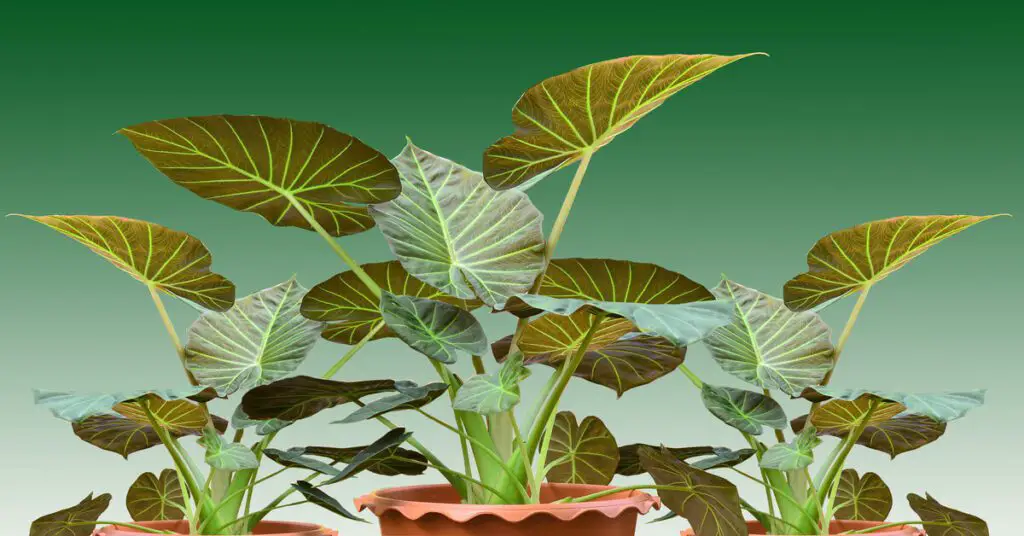Native to Southeast Asia, the Alocasia Regal Shield is a tropical evergreen. If this perennial doesn’t ring a bell, it’s also known by its common name, Elephant Ear.
Hence its name, it’s mainly distinguished by its massive, elephant ear-like leaves. It’s also renowned for its deep-veined, dark green foliage with a matte sheen and its thick trunk or pseudostem. On the undersides of its leaves is a dark purple-red hue. It’s bound to add coarse texture and richness to a space.
Alocasia Regal Shield Care
The alocasia regal shield can be picky with its care. This may come off as a surprise to some as many tropical houseplants are easy to care for.
The good news is, regal shields will make it loud and clear when they’re unhappy. As long as you meet their semi-uptight needs, they should thrive. Speaking of their needs, let’s discuss what they require to survive.
Soil
Neutral to slightly acidic soil is best for regal shields. Go for a soil that isn’t too dense to ensure your moisture-loving alocasia won’t get oversaturated with water. Not enough drainage can cause root rot.
Watering
Alocasias prefer moderate watering. However, only water if the first top few inches of soil is dry. How often it needs water will depend on the temperature, lighting, and humidity.
Lighting
Never let your Alocasia ‘Regal Shield’ get direct sunlight as it can scorch its leaves. Partial, indirect lighting is its favorite. Think morning sun.
Due to its preferences, this plant will best thrive in an east-facing window. It can also do okay in a west-facing window.
Humidity & Temperature
Regal shields are finicky when it comes to humidity and temperature. They’re very sensitive to cold and frost.
To keep them happy, they prefer temperatures between 70 and 85 degrees Fahrenheit. They’re also fans of high humidity between 65 and 80%. You may want to consider getting an air humidifier for your alocasia if grown indoors.
Fertilizing
Don’t fertilize your alocasia in the winter. Instead, fertilize it monthly during the warmer seasons.
Avoid using cheap fertilizers on your elephant ear. Cheap fertilizers often have a high level of salt that tend to be harsh for the poor salt-intolerant regal shield. A good quality, light fertilizer is ideal.
Propagation
Elephant ears are easy to propagate via corms. With a sterile knife, cut the corm from the plant. Try to include some roots. Place the corm in its own pot with soil.
Care for it like any other regal shield plant. Within weeks, it should develop more roots.
Diseases & Pests
Aphids are a common pest of the regal shield, as are spider mites. Others include scale, thrips, and mealybugs.
As for diseases, they’re susceptible to many bacterial and fungal diseases. Some of these include sooty mold, powdery mildew, and leaf blight disease.
Toxicity
Both pets and humans are sensitive to the alocasia regal shield if chewed. The oxalate crystals contained within the plant can trigger oral pain and digestive issues.
Regal Shield Flower
Flowers are rare on the regal shields elephant ear. However, they’re possible.
If the conditions are right, and the plant is mature, your elephant ear might produce white or green flowers. That look similar to those of the peace lily. If they bloom at all, it’ll be during the warmer, sunnier seasons.
Blooms of this alocasia are best encouraged when the temperature and humidity levels are stable.
Alocasia Regal Shield Leaves
While not always easy to care for, the alocasia regal shield is expressive when something’s wrong.
Elephant ear plants that are losing leaves can be either normal or problematic. If losing multiple leaves, this can be due to underwatering. Or changes in its growing conditions, like moving it to a less sunny area.
However, leaf loss in small amounts can be normal for elephant ears. This is because they can’t accommodate too many leaves at a time. Since their foliage is huge, and will drop older leaves to put energy towards newer growth.
Leaves curling on the alocasia regal shield may signify improper care. Lack of light/warmth/humidity, incorrect watering, or too much fertilizer can be causes. A pest infestation or potassium deficiency can also lead to curling of the leaves.
Leaves turning yellow on your plant? The most common cause of this is overwatering or overly moist soil.
If you notice leaf drooping, this is often due to over- or under-watering. The moisture of the soil might be able to give you a clue as to which it might be. Pest infestation or disease are other potential causes.
Alocasia Regal Shield v.s. Wentii
The size and leaf shape of regal shields and wentiis are pretty similar.
Wentii, however, have foliage that is longer and a bit thinner than the regal shield. In addition, the foliage of the regal shield tends to be a deeper green.

